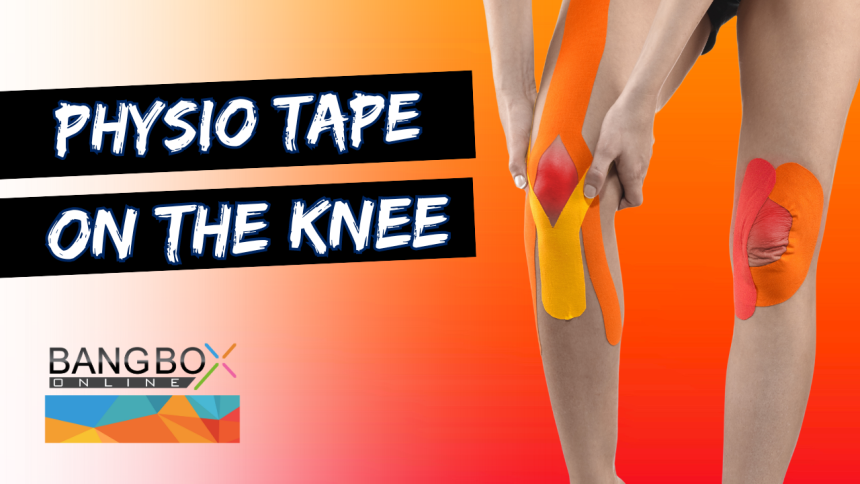
Physio Tape on the Knee
There are many benefits of physio tape in improving quality of life and daily physical activities. - It can help in many ways like managing pain, improving strength, and providing support. Let's discuss what is physio tape and how it can help you.
Physio tape is a therapeutic tape that is used for medical purposes. It is commonly known as K-tape or Kinesio Tape. Other names are sports tape, athletic tape, or supporting tape. The use of physio tape in non-surgical management is not new. It is usually made of cotton and synthetic material. There are 3 kinds of physio tapes available depending on their flexibility: • Rigid • Elastic • KT. They all have different applications according to their elasticity. White rigid tape is used for stability, elastic is used for providing support in muscle actions, and K tape is used for therapeutic purposes. There are many properties of physio tape including: • Stretchable • Elasticity and recoil to original length • Water resistant • Not reactive usually • Take minimum time to get dry.
Uses of physio tape
K-tape is used for many purposes:
Increase ROM
K tape is used to increase the range of motion in hypermobile joints. There is more risk of injury in hypermobile joints, especially in sports. So, physio tape helps players to play safely.
Improve muscle function
Physio tape helps to improve muscle function by providing support to muscle tendons and ligaments. It gives confidence to patients to use full muscle range.
Correct posture
Kinesio taping is also used for correcting and maintaining posture. Physio-taping for knee pain helps the patient to move without aid and with the correct gait. It helps in correcting imbalance walk.
Pain Relief
Taping helps in relieving pain by facilitating or inhibiting muscle action. If the patient feels pain in muscle movement, it aids in completing the movement without pain. Also helps to inhibit muscle action to prevent pain.
Joint stability
Joint stability is also achieved by tapping the muscles around the joint. The weight-bearing joint is the knee and mostly gets injured. Kinesiology tape for knee support helps to prevent injury in weak joints. Physio tape helps the joints that are more prone to injury and reduces the recurrence of injury in the future.
Reduce edema and Swelling
K-Tape helps to reduce inflammation and swelling by lymph drainage. Inflammation is reduced when the blood flow increases by applying physio tape. Swelling is also reduced by draining lymph back to lymph nodes. KT is so helpful in varicose veins and elephantiasis limbs.
Mechanism of action
Physio tape has different ways of action mechanical, neuromuscular, and psychological. Mechanically, physio tape adheres to the skin and lifts off the dermis which allows better blood flow to the area. Lifting of the skin also helps in lymph drainage and eventually reduces swelling and edema. In a neuromuscular way, K-Tape stimulates the mechanoreceptors in the skin and fascia. This stimulus activates the pain-inhibiting response by pain-gate theory. Psychologically, it also acts as a placebo and the patient feels the support to move joints and muscles in a complete range of motion.
Types of K-tape
A wide variety of physio tapes are available in the market like Kinesio Tex Classic, Kinesio Tex Performance, Kinesio Tex Gold, Kinesio Equine, and Kinesio Canine. All these types have specific functions and are used for specific purposes. Kinesio Tex Classic is for universal purposes and is used on healthy skin. Kinesio Tex Performance has a different pattern and texture than the Classic one. It is used for sensitive skin which is at risk of getting any injury. Kinesio Tex Gold is only used by professionals and requires proper training before using it. Kinesio Equine and Kinesio Canine are used for horses and dogs respectively.
Applications of Physio Tape
Physio tape has many applications in different fields of medicine.
OPD
It is used in the outpatient department for pain and stability. K-Tape for knee pain and back support are the most common uses.
Orthopedics
In orthopedics, physio tape is used for alignment and realignment of joints. It is also used to secure muscle action and joint movement. Whether it’s rheumatoid arthritis or osteoarthritis, both are painful conditions for the patient. Kinesiology tape for knee arthritis is also used in the orthopedics department for therapeutic purposes.
Sports
Every sport like cricket, hockey, and football must hire a physiotherapist on the medical board. It’s the physiotherapist who declares the patient fit enough to play the game. A physiotherapist is also present on the grounds to provide immediate help in case of any injury. Soft tissue injuries like Ligament strains and ankle sprains are most common on the ground. The knee’s MCL (medial collateral ligament) is also prone to injury during sports. Sports tape for the knee is used to prevent such injuries and ensure the well-being of a sportsperson. Many other knee conditions like chondromalacia, patellofemoral pain, and runner’s knee also require athletic tapping on the knee.
How to apply physio tape on the knee?
There are different methods to apply KT for every condition. It is always better to seek help from a professional. Here is a step-by-step guide on how to apply physio tape on the knee:
· Take consent from the patient and tell him all the pros and cons of tapping
· Then clean the skin and tap dry it properly
· Try to trim your body hair because hair makes KT less adhering
· Cut two equal pieces of k Tape with scissors
· Make sure to Round the edges before applying
· Don’t touch the adhesive side of the tape
· Place one end on the upper lateral side of the knee and extend it caudally and medially toward the opposite side
· Repeat the same with other sections of KT
· Rub it in a circular direction for better sticking
· Instruct the patient to remove the tape immediately if he feels any kind of itching or irritation
· Also tell the patient the proper method of how to remove tape.
Also, there are some other techniques that show how much tension and stretch to apply on physio tape for better results. The stretch ratio depends on the element to target through taping. For example, skin requires less stretch, and more stretch is needed to target the ligament or tendon. You must know the joint position before application. This all comes with practice and training.
Precautions and Contraindications
Don’t apply Physio Tape to sensitive skin and remove it immediately if it causes itching and redness. Give the patient all the important information about the physio tape and tell him when to take it off. Some general contraindications are:
· Active infection
· High-grade fever
· Abrasive and bruised skin
· Open wound
· DVT
· Malignancy
Side effects of physio tape are also seen if not handled properly. So be careful during the application and ask the patient to share his experience if it is effective for him or not.





